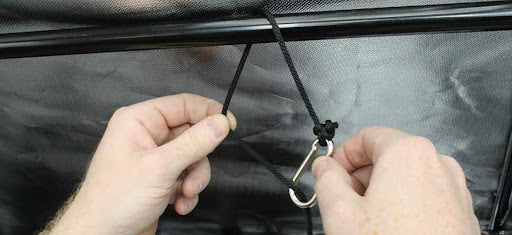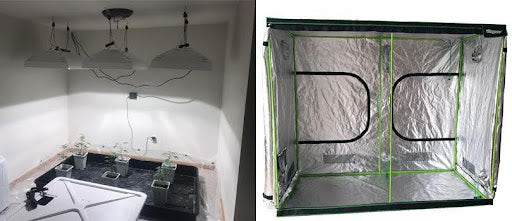How To Hang Your Grow Lights?
Hanging grow lights correctly is an art and a science, critical for turning your seedlings into stunning, healthy plants. But if you're scratching your head about where to begin, worry no more!
This guide is your first step towards mastering the art of using LED grow lights to bring the best out of your indoor garden.
Stick with us, and soon your space will be transformed by the soft, bright colors of thriving plants under the perfect grow lights.
Why Hang Grow Lights?
Indoor plants need enough light to maintain their chemical energy, which influences their overall growth and development. Unfortunately, natural sunlight might not be enough to provide the type of light needed to grow your plants to their fullest potential.
Grow lights can help supplement natural sunlight, and they offer other benefits too, such as extended light hours during winter months. However, to optimize their benefits and provide the appropriate light coverage for your plants, hanging lights is one of the best ways to go.
Hanging your grow lights can help you save on space. By suspending the lights above your plants, you free up room and can place more plants in your grow space. Additionally, suspended grow lights can be properly positioned to give your plants the maximum light intensity possible.
This means that by hanging your lights, you can provide your plants with those extra light rays they need, especially during the vegetative and flowering phases.
How to Hang Your Grow Lights: Detailed Steps Explained

Before you start hanging your grow lights, there are a few things you need to check. Make sure you know the size of your grow tent, the type of plants you'll be growing, and how your indoor electric wiring is set up.
It's super important to have your fan and light on separate outlets and not use any extension cords. This helps prevent any power issues since both fans and lights use a lot of electricity.
Now, let's get into the steps for setting everything up.
Step 1: Choose the Best Spot for Your Light
The first thing you need to do is figure out where to put your light. Most of the time, the very center of your grow space is the best spot. This is because if your tent has shiny Mylar walls, light will bounce around and reach all parts of the tent, even the corners. But if your grow space is really big, like over 5'x5', you might need to split your tent into two sections and use two lights.
For a huge tent, like 10'x5', you might even need extra lights in the corners to make sure every plant gets light and there are no shadowy spots. Don't forget to move your plants around every few days so they all get an even amount of light.
Step 2: Setting Up a Hook or Joist
Our grow tents come with bars on the top where you can hang your lights. The KIND LED lights, for example, come with metal hangers. You can use S-hooks made of stainless steel, rope ratchet hangers, or even zip ties (use a bunch!) to attach your lights to these bars. Rope hangers are great because you can easily change how high your light is over time.
Step 3: Hang Your Grow Lights
After attaching your hangers to the tent, lift your lights and connect them to your hangers. Ideally, your lights should be about 24 inches above your plants. This setup leaves enough space for you to arrange your fan, filter, and ducting at the top of your tent. We're going to talk about the best ways to hang your ventilation in another guide!
Step 4: Fine-Tuning Light Height
Now that your lights are up, it's time to adjust their height. If you're using rope ratchet hangers, this step is super simple. If you're using a different kind of hanger, like S-hooks, you might need to get a bit creative. For instance, you could use some rope to adjust the lamp's height to just the right level.
Preparing to Hang Your Grow Lights

Growing plants indoors requires ample light for healthy growth and development. Having a proper lighting system is the key to thriving indoor plants. For that reason, it's essential to know how to set up grow lights and the right height to hang them. Whether you're new to indoor gardening or a seasoned grower.
Gather Necessary Supplies
If you are planning to grow indoor plants, getting the right grow lights is an essential investment. However, in addition to purchasing the lights, you will also need specific supplies to ensure an efficient and safe installation. Here are some necessary supplies you will need to hang your grow lights:
- Hangers - This includes adjustable hangers or light hangers that will allow you to adjust the lights' heights as per your plant's growth and requirements.
- Fasteners - You will also need fasteners such as hooks, carabiners, or S-hooks to attach the hangers to the rope or cable.
- Cable management - Keeping the cables organized is crucial for both the safety and efficiency of your grow light setup. Zip ties, ropes, or cable ties can come in handy to hold cables together and prevent them from tangling.
- Rope ratchet or cable - A rope ratchet or a cable will help you attach the hangers to your tent support poles securely.
- Spring-loaded rope clip - A spring-loaded rope clip is essential to fasten the rope or cable securely to the pole.
- Additional lights - Depending on the size of your grow space and the type of plant you are growing, you may need to add extra lights. This helps to avoid any dark spots and ensure complete light coverage.
- Rotation system - Plants need even exposure to light to grow uniformly. Therefore, it is essential to have a rotation system in place to rotate the plants regularly and ensure even exposure to the grow lights.
Measure Out the Space
When setting up grow lights for your indoor plants, measuring out the space is crucial. The number of lights and the amount of space they cover will determine how much light your plants receive, which is critical for their growth and health.
To begin measuring your space, start by measuring the distance between your grow beds and the ceiling. This will give you an idea of how much hanging height you have to work with.
Next, consider the maximum PAR (Photosynthetically Active Radiation) under the grow light that you plan on using. PAR is a measurement of how much light plants can use for photosynthesis. You want to make sure that the plants are receiving enough light to thrive, but not too much that they experience light stress.
For example, if you are working with a 2'x2' area, a 250W lamp is generally all that's needed. However, if you are working with a larger area, such as a 4'x4' area, a light bulb between 600w and 1000w should be used to cover all the plants with enough light.
Where Should Grow Lights Be Placed?
When deciding where to place grow lights, consider the plant's growth stage, size of the growing area, height of crops, and environmental factors such as temperature, humidity, and air circulation. For vegetative growth, suspend the lights approximately 24 inches above the plants and 18 to 20 inches for plants in the flowering phase.
If you are using multiple grow lights, ensure even spacing to distribute light coverage evenly throughout the growing area. A good rule of thumb to follow is placing the lights 2 to 3 feet apart, depending on the size of the fixtures being used.
Always use a heavy-duty hook, screw, or nail to hang grow lights from the ceiling and a sturdy chain or cord to support the weight of the light fixture. Make sure that the hook is securely anchored to the ceiling to prevent it from falling and damaging both the lights and plants.
The Right Height to Hang Your Grow Lights

The ideal height to hang your grow lights varies based on the type of plants you're growing and the lighting system you're using. High-Intensity Discharge (HID) lighting systems, which include Metal Halide (MH) and High-Pressure Sodium (HPS), need to be hung between 24" (61cm) to 62" (157cm) above the plants, depending on the system's wattage. These systems produce more intense light and can damage plant leaves if they're placed too close.
On the other hand, compact fluorescent grow lights can be hung closer to your plants, about 5 inches (13cm) above the plant canopy. These lights produce less intense light and release less heat than HID systems, making them less likely to stress or burn plants.
LED grow lights are more versatile and can be hung anywhere from 5 inches (13cm) to 20 inches (51cm) away from the plant's canopy. These lights come with a varying spectrum of light that can cater to the different growth stages of plants, from vegetative growth to flowering phases. Some LED fixtures also come with adjustable hangers, giving you the freedom to change the light's height as per your plant's needs.
Check out this article: LED vs HPS: Which One Is Best For You?
When Should You Adjust The Grow Light's Distance From Plants?
As plants grow taller, they naturally move closer to the grow lights, and the light intensity they receive increases. For this reason, it's crucial to adjust the hanging height of the grow light fixtures to maintain the optimal light intensity at various stages of growth. Increasing the hanging height of the fixtures can help avoid light stress and reduce the risk of damage to the plants, ensuring that they grow healthy and strong.
Similarly, when plants enter the flowering or vegetative stages, their lighting requirements also shift, and the grow light's intensity may need adjustment. At these stages, plants require extra light to support their growth and development, which can only be achieved by adjusting the light's intensity. Failing to do so may result in poor growth and development, leading to reduced yield.
The Takeaway: Hanging Grow Lights
Choosing the right height for hanging your grow lights is super important for keeping your indoor plants happy and healthy. You've got to make sure they're not too close to hurt the leaves but close enough so your plants get all the light they need to grow strong.
Remember, each type of light, whether it's LED, HID, or fluorescent, has its own perfect spot. And don't forget to move the lights up as your plants grow taller!
If you've got more questions or need some more tips on keeping your grow lights just right, hit up our blog. We've got all sorts of helpful guides and articles there.
And if you're in the market for some new LED grow lights, grow tents, or any other indoor gardening supplies, definitely check out our selection. Don’t hesitate to contact us. We’re here to help make your indoor garden a success!
Discover the optimal way to hang grow lights for robust plant growth. Learn placement, height, and adjustment tips for LED, HID, and fluorescent lights.








